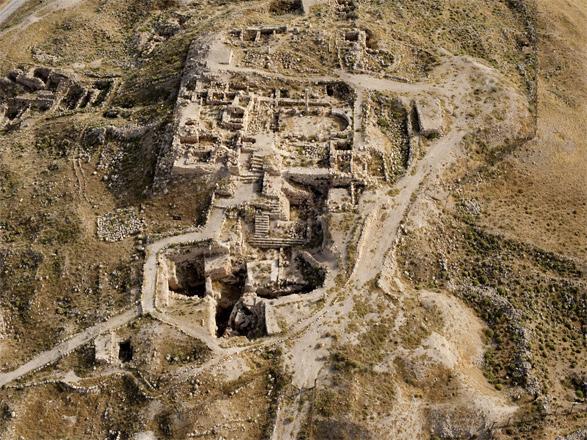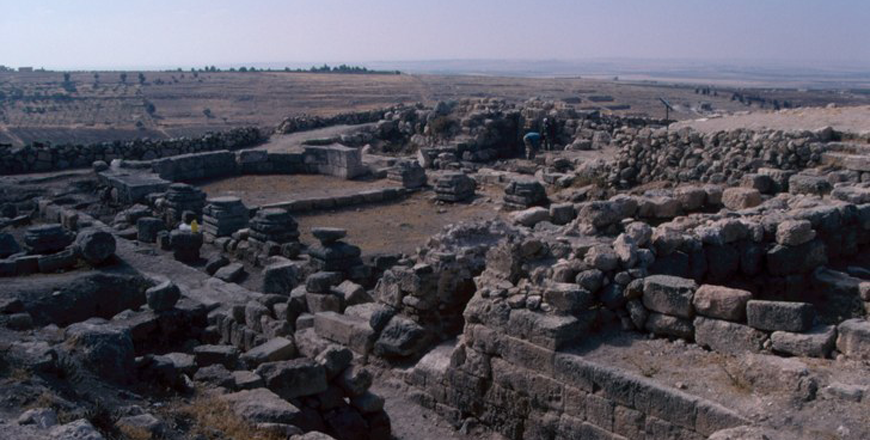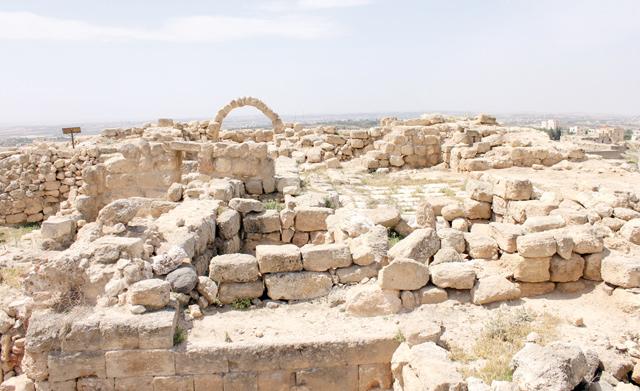You are here
American scholar explores centuries-old agricultural practices in Jordan
By Saeb Rawashdeh - Jul 18,2018 - Last updated at Jul 18,2018

The aerial view of Tell Hisban where researchers unearthed traces of multiple empires and civilisations (Photo courtesy of Bethany Walker)
AMMAN — The Mamluk period (1250-1517) is still a relatively unexplored field for scholars who know very little about the residence patterns of the ruling elite who dwelt in the capital cities of Cairo, Damascus and Karak, an American archaeologist stated, noting that military officers then lived in "both barracks in citadels and palaces of the urban centres”.
These “castles” did not have to be very large, Bethany Walker explained, citing the one at Tall Hisban which was of very modest size yet contained all the facilities needed by the small garrison. She added that the citadels also functioned as prisons, storage facilities and rural administrative centres.
“The muqta’s, who received the income from the iqta’s, generally did not live on their estates. It is possible that their estate managers [wakils] did, though,” said Walker, who received her PhD from the University of Toronto.
Clerics and intellectuals lived in the “civilian” areas of the towns and villages, where some of their houses were identified at Tell Hisban, for example, she explained.
Regarding the size of the population, she said it is "difficult to estimate". "One formula used by archaeologists of the later historical periods was of five people per household, a number loosely based on Ottoman censuses. Unfortunately, none of the Mamluk state’s tax registers or censuses for Bilad Al Sham [Greater Syria] have survived,” Walker noted.
Agriculture was a very significant element of the Mamluk economy in Jordan as cultivation was mixed, relying on cereals (of many different kinds); vegetable fields; and “orchard” crops, like olives, fruits, nuts, the scholar explained, adding that most of these crops were dry-farmed, though some were irrigated on a small scale.
“The cultivation of sugar cane was largely centred in the Jordan Valley, and required extensive irrigation and heavy labour. It was hard on the local soil, and the diversion of water to sugar cane fields was one of the biggest points of conflict between the Mamluk state and local farmers,” Walker underlined.
The production and sale of cane sugar was a state monopoly, and cereal fields were distributed among the members of the military elite (the amirs) as quasi-feudal estates (iqta’at), Walker continued, adding that smaller orchard plots could be bought and sold by local farmers over time.
Regarding cereal production, the cultivation of cereals, and particularly of wheat and barley, was the foundation of the entire economic system of Mamluk-controlled Syria and Egypt. “It was primarily the revenues from cereal fields that provided incomes for the military officer class, and grain prices and distribution [as well as hoarding] were regularly manipulated by state officials for political purposes,” she highlighted, adding that cereals were also one of the most important components of the local diet and provided animal fodder.
It also had other purposes as cereal by-products were used for construction and pottery making.
“Cereal cultivation included the entire community, which sowed, harvested and threshed together,” Walker stressed.
The American scholar now plans future fieldwork at Tell Hisban. “We will continue with the excavation of the well-preserved farmhouses at the base of the tell, with our study of family life and social organisation,” she pointed out.
To better understand the agriculture of the period, scholars will also begin a systematic study of the ancient fields, through documentation and dating of relic terraces. “Analysis of soils, botanical remains, and materials analysis of objects will be done in labs in Jordan and Europe,” Walker continued, noting that the long-term plan includes the launch of the Visitor’s Centre in Tell Hisban and partial restoration of some of the famous farmhouses for the public.
“It is our hope to make visible the lives of farmers and families that lived here hundreds of years ago, and to highlight a community that showed resilience in its response to chronic water shortages and the political uncertainties of Mamluk rule,” Walker underscored.
Related Articles
AMMAN — Tell Hisban, located in the Madaba Plains, represents the “granary of the empires”, noted an American archaeologist.The site, coveri
AMMAN — The Ottoman conquest of the Levant in 1517 had an impact on the economic models of the Mamluk dynasty that ruled the area from
AMMAN — There has been a boom in studies devoted to the Mamluk period (1250-1517) due to a recent “rural turn” in Islamic archaeology, accor














